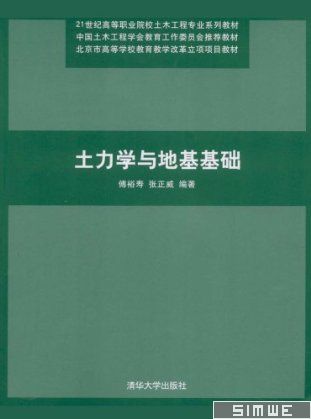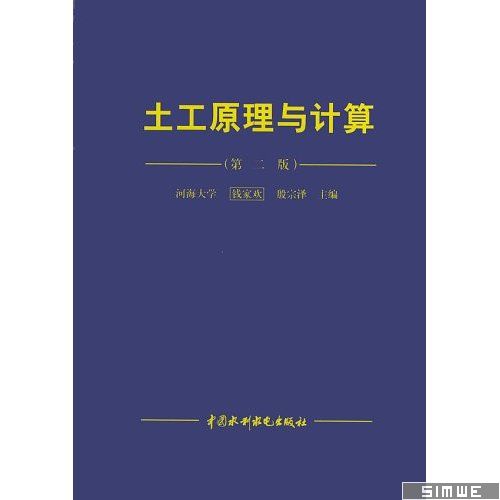Geotechnical Engineering
商品介绍
内容简介
《Geotechnical Engineering for Disaster Mitigation and rehabilitation》内容为:Geotechnical Engineering for Disaster Mitigation and Rehabilitation presentsthe latest developments and case studies in the field. All contributions to thisproceedings were rigorously reviewed to cover the newest developments indisastersrelated to earthquakes, landslides and slopes, soil dynamics, riskassessment and management, disaster mitigation and rehabilitation, andothers. The book will be a useful reference for geotechnical scientists,engineers and professionals in these areas.
编辑推荐
《Geotechnical Engineering for Disaster Mitigation and rehabilitation》由科学出版社出版。
目录
CONTENTS
Preface
Acknowledgements
Qian Jiahuan Lecture
Flow Slides of Underwater Sand Deposits in Jamuna River Bed Kenji Ishihara
Keynote and Special Invited Plenary Lectures
Interaction Between Eurocode 7 - Geotechnical Design and Eurocode 8 – Design for Earthquake Resistance of Foundations P.S. Sêco e Pinto
Liquefaction Mitigation Of Sand Deposits by Granular Piles- An Overview M. R. Madhav, A. Murali Krishna
Estimation of Liquefaction-Induced Settlement of River Dikes and Their Effect in Lowland Area During Earthquakes Susumu Yasuda
Mitigation of Seismic Damage of River Dikes Yasushi Sasaki
Some Aspects of the Mitigations and Rehabilitations of Natural Disasters in Malaysia T.A.Ooi
Seismic Performance Evaluation of Geotechnical Structures Susumu Iai, Tetsuo Tobita
Invited or Special Session Lectures
Debris-Budget-Based Debris-Flow Susceptibility Analysis Jia-Jyun Dong, Chyi-Tyi Lee, Kuang-Ping Lin and Yu-Hsiang Tung
Geosynthetic Reinforcement for Riverside Slope Stability of Levees due to Rapid Drawdown Jie Han, Jianfeng Chen and Zhenshun Hong
Study on Earthquake and Typhoon Induced Regional Debris Flows in Ta-Chia River, Taiwan Ming-Chin Ho, Chien-Jung Chen, Yei-Sain Lee, Cheng-Yu Ku and Sue-Yung Chi
Instrumented Full Scale Test and Numerical Analysis to Investigate Performance of Bamboo Pile-Mattress System as Soil Reinforcement For Coastal Embankment on Soft Clay Masyhur Irsyam, Sugeng Krisnanto and S. P. R. Wardhani
Progressive Damage Simulation of Foundation Pile of The Showa Bridge Caused by Lateral Spreading During the 1964 Niigata Earthquake Motoki Kazama, Noriaki Sento, Ryosuke Uzuoka and Makoto Ishimaru
Earthquake-Induced Submarine Landslides in View of Void Redistribution Takaji Kokusho, Tetsuya Takahashi
Landslide Hazard Mapping Using Monte Carlo Simulation- A Case Study in Taiwan Chia-Nan Liu
Statistical Evaluation for Strength of Pile by Deep Mixing Method Yong Liu, Junjie Zheng and Jia Guo
Limited Flow Behaviour of Sand with Fines under Monotonic and Cyclic Loading S. R.Lo, M.D. Mizanur Rahman and D. Bobei
Travel Distance of Debris Flows Triggered by Slope Failures Hideki Ohta, Hirohiko Kusaka, Yutaka Miura, Katsumi Ohkubo, Masaru Takemoto and Kiyoyuki Amano
Some Numerical Considerations in Unsaturated Slope Stability Analysis due to Rainfall Infiltration Kok Kwang Phoon, Yonggang Cheng
Probabilistic Seismic and Tsunami Hazard Analysis for Design Criteria and Disaster Mitigation in Rehabilitation and Reconstruction of a Coastal Area in City of Banda Aceh I. Wayan Sengara, Hamzah Latief and Syahril B.Kusuma
Some Case Studies on Debris Flow in Peninsular Malaysia B.K. Tan, W.H. Ting
Gps/Gis Integration Used to Establish a Disaster Risk Mapping System for Nantou County in Central Taiwan Kuang-Jung Tsai, Kun-Ting Chen and Chin-Chuan Lin
Types of Flowslide Failures and Possible Failure Mechanisms Dariusz Wanatowski, Jian Chu and Robert S.C. Lo
Disaster Management in Central Java Province, Indonesia S.P.R. Wardani, R.J. Kodoatie
On the Relationship between Reliability Indices for Ultimate and Serviceability Limit States of Building Foundations Yu Wang, Fred H. Kulhawy
Planning Slope Stabilization Actions Limin Zhang, Dianqing Li
Earthquakes and Soil Dynamics
Modeling of Stress-Strain Behavior of Soft Clay under Cyclic Loading Yuanqiang Cai, Jun Wang
Analysis and Evaluation of Ground Vibration Response Induced by Rapid Rail Transit Bin Chen, Guoxing Chen and Xiaomei Su
Dynamic Shear Modulus and Damping Ratio of Recently Deposited Soils in the Coastal Region of Jiangsu Province Guoxing Chen, Binghui Wang and Jianda Liu
Experiment on Earthquake-Induced Permanent Deformation of Nanjing Recently Deposited Muddy Soil Guoxing Chen, Dinghua Zhu, Junjian Shi and Xuezhu Liu
Probabilistic Evaluation of Earthquake-Induced Liquefaction Potential for Large Region Site Based on Two-Dimensional Gis Technique Guoxing Chen, Hao Tang
Evaluation of Liquefaction Potential of Pond Ash Ashim Kanti Dey, S. R. Gandhi
Analysis on Dynamic Response of Cast-in-Place Concrete Thin-Wall Pipe Pile Composite Foundation under Lateral Seismic Excitation Xuanming Ding, Hanlong Liu
The Analysis of Composite Foundation with CFG and Gravel Piles to Resist Soil Liquefaction Yuqin Feng, Yinghao Wang and Chunmei Zhang
Computation of Passive Earth Pressure of Cohesive Backfill on Retaining Wall Considering Earthquake Force Zhen Feng, Na Wang and Lianjun Wang
Applicability of Newly-Developed Instrument for Microtremor Measurements to Estimate the Loosened Zone in Shallow Ground Taiji Hanakawa, Seiji Kano, Toshikazu Sawamatsu and Koji Ichii
Experimental Study on the Relationship between Degree of Saturation and P-Wave Velocity in Sandy Soils Munenori Hatanaka, Takemi Masuda
Effects of Anisotropic Consolidation and Initial Shear Load on Liquefaction Resistance of Sand in Simple Shear Condition Yasuyo Hosono, Mitsutoshi Yoshimine
The Research on Dynamic Rheological Mechanical Response and Rheological Dynamic Model of Geological Disaster of Soft Rock-Soil Hua Hu, Hengxing Gu and Dengrong Yu
Seismic Responses of Bridge Pier Considering the Effect of Hydrodynamic Pressure Furong Li, Guoxing Chen and Zhihua Wang
Numerical Study on Sandpile Formation of Granular Materials with Different Grain Size Distributions Jun Liu, Jing Zhou
Analysis of Seismic Disaster of Masonry Pagodas Junlong Lu, Yin Zhang and Qianfeng Yao
Liquefaction of Sand under Bi-Directional Cyclic Loading Maotian Luan, Dan Jin, Zhendong Zhang and Qiyi Zhang
Earthquake Shocks and Liquefaction Threat to Dha and Clifton Areas, Karachi Pakistan. a Case Study Syed Amir Mahmud, Shamim Ahmed Sheikh
Study on Dynamic Properties of Saturated Clay and Undisturbed Silty Clay Ying Nie, Maotian Luan, Qi Shao, Shujie Liu and Meng Wang
Numerical Simulation of Dynamic Compaction Using Ls-Dyna Xiayong Qin, Maotian Luan, Qing Yang, Xiaojie Li and Zheng Zhao
Axial Vibration of Floating Pile Groups with Flexible Caps Q. Ren, M.S. Huang
Estimation of Ground Motion Parameters for Muzaffarabad Earthquake, Pakistan on 8th OCTOBER 2005 D. Neelima Satyam, K.S. Rao and M.R. Madhav
Effective Stress Analysis for the Effects of Liquefaction Condition on Ground Motions J. Z. Sun, G. L. Shi
Influence of Cushion on Dynamic Response of Cast-in-Place Concrete Thin-Wall Pipe Pile Composite Foundation under Lateral Seismic Excitation Huiming Tan, Hanlong Liu
Numerical Modelling of Seismic Performances of Passive Pile Groups Adjacent to Soil Slope Mingwu Wang, Li Li
Dynamic Behaviour of Rigidly-Capped Pile Groups of Vertical and Rocking Oscillations Bin Yan, Lihua Liu, Xiaotong Peng and Mingdong Wang
Effects of Single Joint with Different Nonlinear Normal Deformationalbehaviors on P-Wave Propagation J. Yu
Geotechnical and Seismic Hazard Study for a Marine Site Development in Southern California Endi Zhai, Liping Yan
Numerical Analyses of Dynamic Response of Saturated Porous Seabed-Pipeline Interaction under Seismic Loading Xiaoling Zhang, Maotian Luan
Landslides and Slopes
Deformation and Stability Analyses of a Pile Supported T-Wall with Deep Mixed Shear Panels in Plaquemines Parish, Louisianna Tiffany E. Adams, George M. Filz, Peter R. Cali and Mark L. Woodward
Analysis of Typical Expansive Soil Slope Project Liang Chen, Pei Zhang and Sheng Lu
Study on Parameters Sensibility Analysis Model of Landslide Stability Considering Correlation Shengguo Cheng, Xianqi Luo
Evaluation of Bianloo Landslide Using Cellular Automata A. Fahimifar, M. A. Bahri
The Limit Analysis of Reinforced Slopes Xiaojing Feng, Qing Yang
Study on Rainwater Infiltration in Subsoil of Sandy Slopes during Rainfall by Field Monitoring Thi Ha, Yasushi Sasaki, Takashi Tsuchida and Seiji Kano
Acid Mine Drainage Erosion and Earthquake Coupling Action to Slope in Rich Sulfide Open Pit Lichun Jiang, Jilong Zhang
Danger of the Landslide Activity of Slopes on the Railway Line China – Kyrgyzstan – Uzbekistan on Site Karasu-Torugart K.Ch. Kojogulov, O.V. Nikolskay
Study on Uplift Test of Pressure-Dispersive Prestressed Cable in Slope Reinforcement Project Wei Li, Haigui Kang
Application of in Situ Stress Regression Method in Rock Slope Stability Analysis Yao Liang, Depei Zhou, Tao Yang and Gang Zhao
Displacement Characteristic of Soil Slope in Shear Strength Reduction Method Based on Mohr-Coulomb Model Hang Lin, Ping Cao, Jiangteng Li and Xueliang Jiang
An Interface Model to Predict the Stability of Landslide with Weak Intercalated Layer Yulong Luo, Hua Peng
Catastrophe Evaluation of Landslide Instability Qiang Ren, Weiya Xu
Nonlinear Finite Element Reliability Analysis of Slope Stability Xiaohui Tan, Jianguo Wang
Finite Element Analysis of Strain Localization Problems for Slope Based on Cosserat Continuum Model Hongxiang Tang, Daguo Wang
Evaluation of In-Situ Shear Strength of Natural Slopes Vulnerable to Heavy Rainfall by Lightweight Dynamic Cone Penetrometer Takashi Tsuchida, A.M.R.G. Athapaththu, Seiji Kano and Kazuaki Suga
The Visualization Study of a Green Slope System Baocheng Wei, Zhende Zhu and Qing Wang
Application of Nonlinear Time Series Analysis in Slope Deformation Analysis and Forecast Jia Xu, Fenghai Ma
The 3-D Stochastic Analysis of Progressive Failure of Rock Slopes Lingqiang Yang, Jing Ma and Zuping Chen
Numerical Simulation Analysis on Stability of a Surrounding Rock of Underground Cavities Yisi Zhuge, Xiutong
Preface
Acknowledgements
Qian Jiahuan Lecture
Flow Slides of Underwater Sand Deposits in Jamuna River Bed Kenji Ishihara
Keynote and Special Invited Plenary Lectures
Interaction Between Eurocode 7 - Geotechnical Design and Eurocode 8 – Design for Earthquake Resistance of Foundations P.S. Sêco e Pinto
Liquefaction Mitigation Of Sand Deposits by Granular Piles- An Overview M. R. Madhav, A. Murali Krishna
Estimation of Liquefaction-Induced Settlement of River Dikes and Their Effect in Lowland Area During Earthquakes Susumu Yasuda
Mitigation of Seismic Damage of River Dikes Yasushi Sasaki
Some Aspects of the Mitigations and Rehabilitations of Natural Disasters in Malaysia T.A.Ooi
Seismic Performance Evaluation of Geotechnical Structures Susumu Iai, Tetsuo Tobita
Invited or Special Session Lectures
Debris-Budget-Based Debris-Flow Susceptibility Analysis Jia-Jyun Dong, Chyi-Tyi Lee, Kuang-Ping Lin and Yu-Hsiang Tung
Geosynthetic Reinforcement for Riverside Slope Stability of Levees due to Rapid Drawdown Jie Han, Jianfeng Chen and Zhenshun Hong
Study on Earthquake and Typhoon Induced Regional Debris Flows in Ta-Chia River, Taiwan Ming-Chin Ho, Chien-Jung Chen, Yei-Sain Lee, Cheng-Yu Ku and Sue-Yung Chi
Instrumented Full Scale Test and Numerical Analysis to Investigate Performance of Bamboo Pile-Mattress System as Soil Reinforcement For Coastal Embankment on Soft Clay Masyhur Irsyam, Sugeng Krisnanto and S. P. R. Wardhani
Progressive Damage Simulation of Foundation Pile of The Showa Bridge Caused by Lateral Spreading During the 1964 Niigata Earthquake Motoki Kazama, Noriaki Sento, Ryosuke Uzuoka and Makoto Ishimaru
Earthquake-Induced Submarine Landslides in View of Void Redistribution Takaji Kokusho, Tetsuya Takahashi
Landslide Hazard Mapping Using Monte Carlo Simulation- A Case Study in Taiwan Chia-Nan Liu
Statistical Evaluation for Strength of Pile by Deep Mixing Method Yong Liu, Junjie Zheng and Jia Guo
Limited Flow Behaviour of Sand with Fines under Monotonic and Cyclic Loading S. R.Lo, M.D. Mizanur Rahman and D. Bobei
Travel Distance of Debris Flows Triggered by Slope Failures Hideki Ohta, Hirohiko Kusaka, Yutaka Miura, Katsumi Ohkubo, Masaru Takemoto and Kiyoyuki Amano
Some Numerical Considerations in Unsaturated Slope Stability Analysis due to Rainfall Infiltration Kok Kwang Phoon, Yonggang Cheng
Probabilistic Seismic and Tsunami Hazard Analysis for Design Criteria and Disaster Mitigation in Rehabilitation and Reconstruction of a Coastal Area in City of Banda Aceh I. Wayan Sengara, Hamzah Latief and Syahril B.Kusuma
Some Case Studies on Debris Flow in Peninsular Malaysia B.K. Tan, W.H. Ting
Gps/Gis Integration Used to Establish a Disaster Risk Mapping System for Nantou County in Central Taiwan Kuang-Jung Tsai, Kun-Ting Chen and Chin-Chuan Lin
Types of Flowslide Failures and Possible Failure Mechanisms Dariusz Wanatowski, Jian Chu and Robert S.C. Lo
Disaster Management in Central Java Province, Indonesia S.P.R. Wardani, R.J. Kodoatie
On the Relationship between Reliability Indices for Ultimate and Serviceability Limit States of Building Foundations Yu Wang, Fred H. Kulhawy
Planning Slope Stabilization Actions Limin Zhang, Dianqing Li
Earthquakes and Soil Dynamics
Modeling of Stress-Strain Behavior of Soft Clay under Cyclic Loading Yuanqiang Cai, Jun Wang
Analysis and Evaluation of Ground Vibration Response Induced by Rapid Rail Transit Bin Chen, Guoxing Chen and Xiaomei Su
Dynamic Shear Modulus and Damping Ratio of Recently Deposited Soils in the Coastal Region of Jiangsu Province Guoxing Chen, Binghui Wang and Jianda Liu
Experiment on Earthquake-Induced Permanent Deformation of Nanjing Recently Deposited Muddy Soil Guoxing Chen, Dinghua Zhu, Junjian Shi and Xuezhu Liu
Probabilistic Evaluation of Earthquake-Induced Liquefaction Potential for Large Region Site Based on Two-Dimensional Gis Technique Guoxing Chen, Hao Tang
Evaluation of Liquefaction Potential of Pond Ash Ashim Kanti Dey, S. R. Gandhi
Analysis on Dynamic Response of Cast-in-Place Concrete Thin-Wall Pipe Pile Composite Foundation under Lateral Seismic Excitation Xuanming Ding, Hanlong Liu
The Analysis of Composite Foundation with CFG and Gravel Piles to Resist Soil Liquefaction Yuqin Feng, Yinghao Wang and Chunmei Zhang
Computation of Passive Earth Pressure of Cohesive Backfill on Retaining Wall Considering Earthquake Force Zhen Feng, Na Wang and Lianjun Wang
Applicability of Newly-Developed Instrument for Microtremor Measurements to Estimate the Loosened Zone in Shallow Ground Taiji Hanakawa, Seiji Kano, Toshikazu Sawamatsu and Koji Ichii
Experimental Study on the Relationship between Degree of Saturation and P-Wave Velocity in Sandy Soils Munenori Hatanaka, Takemi Masuda
Effects of Anisotropic Consolidation and Initial Shear Load on Liquefaction Resistance of Sand in Simple Shear Condition Yasuyo Hosono, Mitsutoshi Yoshimine
The Research on Dynamic Rheological Mechanical Response and Rheological Dynamic Model of Geological Disaster of Soft Rock-Soil Hua Hu, Hengxing Gu and Dengrong Yu
Seismic Responses of Bridge Pier Considering the Effect of Hydrodynamic Pressure Furong Li, Guoxing Chen and Zhihua Wang
Numerical Study on Sandpile Formation of Granular Materials with Different Grain Size Distributions Jun Liu, Jing Zhou
Analysis of Seismic Disaster of Masonry Pagodas Junlong Lu, Yin Zhang and Qianfeng Yao
Liquefaction of Sand under Bi-Directional Cyclic Loading Maotian Luan, Dan Jin, Zhendong Zhang and Qiyi Zhang
Earthquake Shocks and Liquefaction Threat to Dha and Clifton Areas, Karachi Pakistan. a Case Study Syed Amir Mahmud, Shamim Ahmed Sheikh
Study on Dynamic Properties of Saturated Clay and Undisturbed Silty Clay Ying Nie, Maotian Luan, Qi Shao, Shujie Liu and Meng Wang
Numerical Simulation of Dynamic Compaction Using Ls-Dyna Xiayong Qin, Maotian Luan, Qing Yang, Xiaojie Li and Zheng Zhao
Axial Vibration of Floating Pile Groups with Flexible Caps Q. Ren, M.S. Huang
Estimation of Ground Motion Parameters for Muzaffarabad Earthquake, Pakistan on 8th OCTOBER 2005 D. Neelima Satyam, K.S. Rao and M.R. Madhav
Effective Stress Analysis for the Effects of Liquefaction Condition on Ground Motions J. Z. Sun, G. L. Shi
Influence of Cushion on Dynamic Response of Cast-in-Place Concrete Thin-Wall Pipe Pile Composite Foundation under Lateral Seismic Excitation Huiming Tan, Hanlong Liu
Numerical Modelling of Seismic Performances of Passive Pile Groups Adjacent to Soil Slope Mingwu Wang, Li Li
Dynamic Behaviour of Rigidly-Capped Pile Groups of Vertical and Rocking Oscillations Bin Yan, Lihua Liu, Xiaotong Peng and Mingdong Wang
Effects of Single Joint with Different Nonlinear Normal Deformationalbehaviors on P-Wave Propagation J. Yu
Geotechnical and Seismic Hazard Study for a Marine Site Development in Southern California Endi Zhai, Liping Yan
Numerical Analyses of Dynamic Response of Saturated Porous Seabed-Pipeline Interaction under Seismic Loading Xiaoling Zhang, Maotian Luan
Landslides and Slopes
Deformation and Stability Analyses of a Pile Supported T-Wall with Deep Mixed Shear Panels in Plaquemines Parish, Louisianna Tiffany E. Adams, George M. Filz, Peter R. Cali and Mark L. Woodward
Analysis of Typical Expansive Soil Slope Project Liang Chen, Pei Zhang and Sheng Lu
Study on Parameters Sensibility Analysis Model of Landslide Stability Considering Correlation Shengguo Cheng, Xianqi Luo
Evaluation of Bianloo Landslide Using Cellular Automata A. Fahimifar, M. A. Bahri
The Limit Analysis of Reinforced Slopes Xiaojing Feng, Qing Yang
Study on Rainwater Infiltration in Subsoil of Sandy Slopes during Rainfall by Field Monitoring Thi Ha, Yasushi Sasaki, Takashi Tsuchida and Seiji Kano
Acid Mine Drainage Erosion and Earthquake Coupling Action to Slope in Rich Sulfide Open Pit Lichun Jiang, Jilong Zhang
Danger of the Landslide Activity of Slopes on the Railway Line China – Kyrgyzstan – Uzbekistan on Site Karasu-Torugart K.Ch. Kojogulov, O.V. Nikolskay
Study on Uplift Test of Pressure-Dispersive Prestressed Cable in Slope Reinforcement Project Wei Li, Haigui Kang
Application of in Situ Stress Regression Method in Rock Slope Stability Analysis Yao Liang, Depei Zhou, Tao Yang and Gang Zhao
Displacement Characteristic of Soil Slope in Shear Strength Reduction Method Based on Mohr-Coulomb Model Hang Lin, Ping Cao, Jiangteng Li and Xueliang Jiang
An Interface Model to Predict the Stability of Landslide with Weak Intercalated Layer Yulong Luo, Hua Peng
Catastrophe Evaluation of Landslide Instability Qiang Ren, Weiya Xu
Nonlinear Finite Element Reliability Analysis of Slope Stability Xiaohui Tan, Jianguo Wang
Finite Element Analysis of Strain Localization Problems for Slope Based on Cosserat Continuum Model Hongxiang Tang, Daguo Wang
Evaluation of In-Situ Shear Strength of Natural Slopes Vulnerable to Heavy Rainfall by Lightweight Dynamic Cone Penetrometer Takashi Tsuchida, A.M.R.G. Athapaththu, Seiji Kano and Kazuaki Suga
The Visualization Study of a Green Slope System Baocheng Wei, Zhende Zhu and Qing Wang
Application of Nonlinear Time Series Analysis in Slope Deformation Analysis and Forecast Jia Xu, Fenghai Ma
The 3-D Stochastic Analysis of Progressive Failure of Rock Slopes Lingqiang Yang, Jing Ma and Zuping Chen
Numerical Simulation Analysis on Stability of a Surrounding Rock of Underground Cavities Yisi Zhuge, Xiutong
序言
This 2nd International Conference on Geotechnical Engineering for Disaster Mitigation andRehabilitation (GEDMAR08), held at the Hohai University, Nanjing, China from 30 May to 2 June,2008, is one of the activities of International Society for Soil Mechanics and GeotechnicalEngineering (ISSMGE) Technical Committee TC39: Geotechnical Engineering for Coastal DisasterMitigation and Rehabilitation. It is organized jointly by Hohai University, Chinese Institution of SoilMechanics and Geotechnical Engineering (CCES), and Chinese Society of EnvironmentalGeotechnics (CSRME) under the support of TC39, TC4 on Earthquake Geotechnical Engineering andAssociated Problems, and the Joint Working Group on Geotechnical Engineering for DisasterMitigation and Rehabilitation (JWG-DMR). This conference is the second in the series. The firstconference was held at the Furama Riverfront Hotel in Singapore from 12-13 December 2005.
One hundred and forty-four papers from 20 countries and regions are included in this Proceedings.The papers were selected from more than 200 abstract submissions after a rigorous review process.This Proceedings contains 7 keynote and special invited plenary lectures written by internationalrenowned experts and 18 special session and invited papers that reflect the special topics discussed inthis conference. Not all the keynote or invited papers are included in this Proceedings due to variousconstraints. The other 119 papers cover a range of topics including disasters related to earthquake,landslide, soil dynamics, risk assessment and management, slopes, disaster mitigation andrehabilitation and others.
One hundred and forty-four papers from 20 countries and regions are included in this Proceedings.The papers were selected from more than 200 abstract submissions after a rigorous review process.This Proceedings contains 7 keynote and special invited plenary lectures written by internationalrenowned experts and 18 special session and invited papers that reflect the special topics discussed inthis conference. Not all the keynote or invited papers are included in this Proceedings due to variousconstraints. The other 119 papers cover a range of topics including disasters related to earthquake,landslide, soil dynamics, risk assessment and management, slopes, disaster mitigation andrehabilitation and others.
文摘
插图:
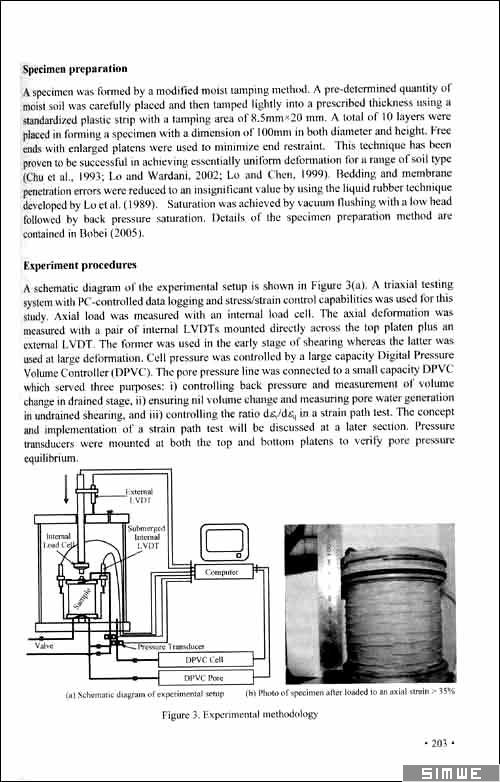
A specimen was formed by a modified moist tamping method. A pre-determined quantity ofmoist soil was carefully placed and then tamped lightly into a prescribed thickness using astandardized plastic strip with a tamping area of 8.5mm*20 mm. A total of 10 layers wereplaced in forming a specimen with a dimension of 100mm in both diameter and height. Freeends with enlarged platens were used to minimize end restraint. This technique has beenproven to be successful in achieving essentially uniform deformation for a range of soil type(Chu et al., 1993; Lo and Wardani, 2002; Lo and Chen, 1999). Bedding and membranepenetration errors were reduced to an insignificant value by using the liquid rubber techniquedeveloped by Lo et al. (1989). Saturation was achieved by vacuum flushing with a low headfollowed by back pressure saturation. Details of the specimen preparation method arecontained in Bobei (2005).Experiment procedures
A schematic diagram of the experimental setup is shown in Figure 3(a). A triaxial testingsystem with PC-controlled data logging and stress/strain control capabilities was used for thisstudy. Axial load was measured with an internal load cell. The axial deformation wasmeasured with a pair of internal LVDTs mounted directly across the top platen plus anexternal LVDT. The former was used in the early stage of shearing whereas the latter wasused at large deformation. Cell pressure was controlled by a large capacity Digital PressureVolume Controller (DPVC). The pore pressure line was connected to a small capacity DPVCwhich served three purposes: i) controlling back pressure and measurement of volumechange in drained stage, ii) ensuring nil volume change and measuring pore water generationin undrained shearing, and iii) controlling the ratio de.v/deq in a strain path test. The conceptand implementation of a strain path test will be discussed at a later section. Pressuretransducers were mounted at both the top and bottom platens to verify pore pressureequilibrium.

A specimen was formed by a modified moist tamping method. A pre-determined quantity ofmoist soil was carefully placed and then tamped lightly into a prescribed thickness using astandardized plastic strip with a tamping area of 8.5mm*20 mm. A total of 10 layers wereplaced in forming a specimen with a dimension of 100mm in both diameter and height. Freeends with enlarged platens were used to minimize end restraint. This technique has beenproven to be successful in achieving essentially uniform deformation for a range of soil type(Chu et al., 1993; Lo and Wardani, 2002; Lo and Chen, 1999). Bedding and membranepenetration errors were reduced to an insignificant value by using the liquid rubber techniquedeveloped by Lo et al. (1989). Saturation was achieved by vacuum flushing with a low headfollowed by back pressure saturation. Details of the specimen preparation method arecontained in Bobei (2005).Experiment procedures
A schematic diagram of the experimental setup is shown in Figure 3(a). A triaxial testingsystem with PC-controlled data logging and stress/strain control capabilities was used for thisstudy. Axial load was measured with an internal load cell. The axial deformation wasmeasured with a pair of internal LVDTs mounted directly across the top platen plus anexternal LVDT. The former was used in the early stage of shearing whereas the latter wasused at large deformation. Cell pressure was controlled by a large capacity Digital PressureVolume Controller (DPVC). The pore pressure line was connected to a small capacity DPVCwhich served three purposes: i) controlling back pressure and measurement of volumechange in drained stage, ii) ensuring nil volume change and measuring pore water generationin undrained shearing, and iii) controlling the ratio de.v/deq in a strain path test. The conceptand implementation of a strain path test will be discussed at a later section. Pressuretransducers were mounted at both the top and bottom platens to verify pore pressureequilibrium.
相关图书
商品评价
最新上架
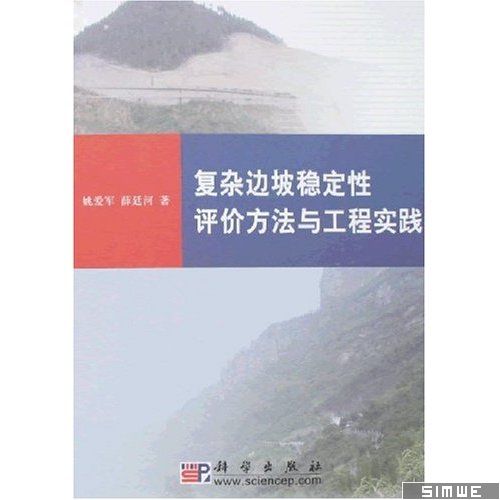
复杂边坡稳定性评价方法与工程实践
优惠价:27.5元
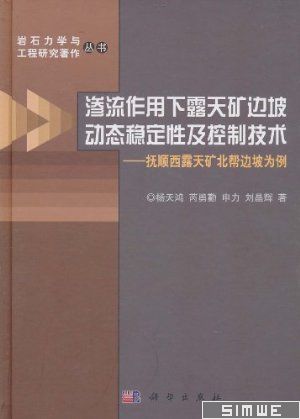
渗流作用下露天矿边坡动态稳定性及控制技术
优惠价:36.1元
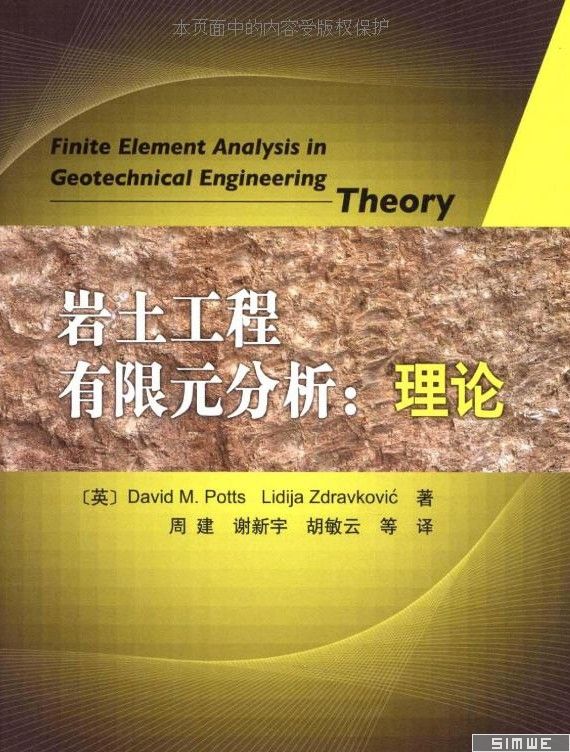
岩土工程有限元分析:理论
优惠价:38.6元
推荐图书

复杂边坡稳定性评价方法与工程实践
优惠价:27.5元
热门期刊
您浏览过的图书
高等土力学
优惠价:43.5元
Geotechnical Engineering
优惠价:35.8元
土力学与地基基础
优惠价:14.3元
土工原理与计算(第2版)
优惠价:56.5元
浏览过本图书的人还喜欢
复杂边坡稳定性评价方法与工程实践
优惠价:27.5元
渗流作用下露天矿边坡动态稳定性及控制技术
优惠价:36.1元
岩土工程有限元分析:理论
优惠价:38.6元
岩土工程数值分析
优惠价:36元



